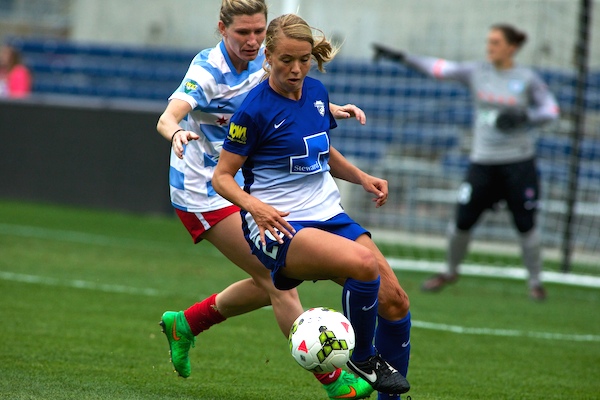So far, the women’s 2015 World Cup has been a great success. Sure, it’s had its sore spots: the cringe-inducing spectacle of people playing soccer on artificial turf that literally melts their cleats and burns their feet; the lackluster performance of the United States team so far; the mostly empty stadiums for some Round of 16 games; but overall, it’s been a great time for soccer and women’s sports in general. The games have been fast, exciting, and as a whole, quite competitive. There have been viewing parties all over the country, from bars and living rooms to town squares and outside city halls. Even President Obama got into the act, showing support for the U.S. team.
Good luck Team USA – make us proud out there! #OneNationOneTeam pic.twitter.com/btu3dRXPbr
— President Obama (@POTUS) June 22, 2015
One way that you can tell that women’s sports has hit the jackpot of popular support with this World Cup is by noting how quickly and vociferously opponents of equality in sport get shouted down in the media. Early this week, Sports Illustrated’s Andy Benoit provided an example when he tweeted his belief that women’s sports in general are not worth watching. As you might expect, Benoit was roundly condemned for his tweet. He was mocked by former Saturday Night Live actors Amy Poehler and Seth Myers (who themselves were good-naturedly mocked by Fox Sports 1’s Jay Onrait and Dan O’Toole). His contention that women’s sports are not worth watching was debunked by innumerable columnists around the country, my favorite of which was Will Leitch in Sports on Earth who argued that anyone who thinks women’s sports are boring, are in fact, boring themselves:
People like Benoit toss out these justifications for not watching women’s sports out of some sort of faux sports purity, like he’s really just out to watch the pinnacle of athletic achievement every night, like anything less than the “best” and the “fastest” and the “strongest” is somehow a waste of one’s time. But this isn’t why we watch sports at all; we watch because every game we watch, we have a chance to see something we’ve never seen before. Dismissing that out of hand isn’t a way of demanding the highest quality performance every game (as if that’s something that could be done anyway); it’s a way of confirming your preexisting biases. It also devalues the actual athleticism on display, and the amount of work it required of everyone to get there.
Although the reaction against Benoit’s comment suggests that he was voicing a fringe, minority opinion, he was not. His attitude towards women’s sports is quite mainstream. Benoit simply made the mistake of speaking out against women’s sports during the World Cup, one of women’s sports two or three most popular events at a time when it’s never been more popular. If you think anything he said was new, you should watch this bitingly ironic video the Norwegian national team made before the World Cup began:
Negative attitudes like the ones the Norwegian team mocked in their video are all too common in the sports world and are relatively safe to voice during the 45 months out of every 48 when a World Cup or Olympics is not going on. This is bad for elite female athletes, it’s bad for people who love watching sports, it’s bad for girls who aspire to be athletes and their parents. I actually can’t think of anyone it is good for. It’s bad for everyone. Unfortunately, as popular as events like the World Cup and Olympics are, they can’t solve the problem because they only come around once every four years. To solve the gender inequalities in sports, a more consistent, permanent force is needed.
Tanya Wheeless, a former executive of the professional basketball teams, the Phoenix Mercury and Suns, wrote recently about the challenge of sustaining interest in women’s sports beyond the World Cup in Time magazine. She suggests that the critical variable in equalizing the opportunities and rewards provided by sports to women is investment:
What if the likes of Nike, Adidas, Coke, and Gatorade spent as much promoting female athletes as they did men? What if women’s leagues had the same marketing budget as men’s leagues? What if the National Women’s Soccer League got as much airtime in the U.S. as the English Premier League?
Naysayers will say all of that would happen if the interest were there. I say, increase promotion and the interest will follow. It’s the difference between having a market and creating one.
Wheeless could not be more right. The future of women’s sports must be bolstered by strong professional leagues. Professional leagues provide opportunities for athletes to get the training and experience they need to become world class. Without strong professional leagues, athletes are left making gut-wrenching decisions, like that of Noora Raty, perhaps the best women’s hockey goalie in the world, who retired at 24 for financial reasons, or Monica Quinteros, the 26 year-old Ecuadorian soccer player who left her job as a gym teacher to play in this year’s World Cup. You think they might have stuck with their sports if they could have made a living doing so? Yeah, so do I.
We don’t need to leave it to “Nike, Adidas, Coke, and Gatorade.” We can do something about this ourselves. We can contribute to equality and the success of women’s sports by becoming a fan of an existing women’s professional team. That’s exactly what I aim to do with the local professional women’s soccer team, the Boston Breakers. I’ve been to one game so far this year and it was a lot of fun. Held in a Harvard University complex convenient to most of the greater Boston area, Breakers games provide high-quality soccer in a thoroughly enjoyable atmosphere. I’m going again this Sunday when the Breakers take on the Western New York Flash at 5 p.m. Tickets are available and affordable. Join me!
There’s really no excuse to continue watching only male sports. There are successful women’s basketball and soccer leagues: the WNBA and NWSL, and later this year, a brand new professional women’s ice hockey league, the NWHL will begin. The WNBA is carried on television by the ESPN family of channels and you can buy streaming access to all the games for only $15. The NWSL goes a step further and puts all of its games on Youtube for free! If you’re reading this post now, you can watch those games. So join me, over the next year and more, in supporting women’s sports by putting our eyes and our wallets were our mouths are!




